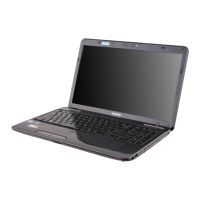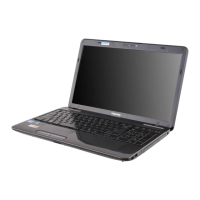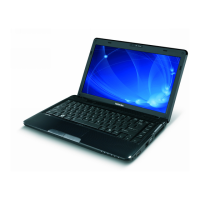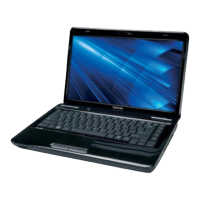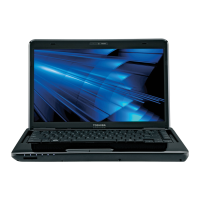
Do you have a question about the Toshiba Satellite Pro L650 Series and is the answer not in the manual?
| Processor | Intel Core i3/i5/i7 |
|---|---|
| Chipset | Intel HM55 Express |
| RAM | Up to 8GB DDR3 |
| Display | 15.6-inch HD (1366x768) |
| Graphics | Intel HD Graphics |
| Storage | 250GB/320GB/500GB HDD |
| Optical Drive | DVD SuperMulti |
| Networking | Wi-Fi 802.11b/g/n, Ethernet |
| Ports | USB 2.0, VGA, HDMI, Headphone |
| Operating System | Windows 7 Professional |
| Battery | 6-cell Li-ion |
Details the ports and components on the computer's left side.
Details the ports and components on the computer's right side.
Explains components and features on the bottom of the computer.
Illustrates the computer's front when the display panel is open.
Explains the function of system status LED indicators.
Provides an overview of the computer's hardware components.
Highlights unique or advanced features of the computer.
Lists and describes pre-installed software utilities.
Discusses optional hardware that can expand computer capabilities.
Explains how to use the computer's touchpad for navigation.
Describes the functionality and use of the built-in webcam.
Details how to set up and use facial recognition for login.
Covers wireless features like Wi-Fi and Bluetooth.
Describes how to connect to a Local Area Network.
Explains the purpose of function keys F1 through F9.
Details how to use the FN key with other keys for special functions.
Lists keyboard shortcuts for quick system changes.
Explains how to check the computer's power status using indicators.
Details the meanings of different battery indicator light states.
States compliance with FCC rules for digital devices.
Explains approval for pan-European terminal connection.
Details network compatibility and conditional requirements.
Explains mandatory region setting for modem use in Japan.
Details Austel permit requirements for modems in Australia.
Provides usage guidelines for modems in New Zealand.
Information related to TEAC optical disc drives.
Instructions for ensuring proper airflow and preventing overheating.
Lists items included with the computer for setup.
Lists pre-installed operating system and utility software.
Step-by-step guide to connect the AC adapter for power.
Instructions on how to open and adjust the display panel.
Procedure for powering on the computer.
Guidance for initial setup after powering on.
Explains methods for shutting down the computer.
Details how to put the computer into Sleep Mode.
Explains how Hibernation Mode saves system state.
Procedures for restarting the computer.
Information on accessing system recovery tools.
Steps to create backup media for system recovery.
Describes the HW Setup window and its configuration options.
Options for setting or resetting user and supervisor passwords.
Settings for customizing the internal or external display.
How to set the sequence for booting the computer.
Configuration options for SATA and eSATA interfaces.
Guidelines for identifying and resolving computer issues.
Basic checks to perform before troubleshooting.
Questions to ask when diagnosing malfunctions.
Troubleshooting hard disk drive boot problems.
Common issues with the DVD drive.
Troubleshooting modem connection and communication issues.
Information on how to contact TOSHIBA for help.
Details the computer's physical size.
Specifies operating and non-operating conditions.
Explains the function of the display controller.
How to configure display settings for video output.
Technical details about the wireless LAN card.
Lists supported Wi-Fi frequency bands and channels.
Discusses health considerations and safety guidelines.
Compliance statements for different regions.
Lists certification bodies for power cords.
How to launch the health monitoring application.
What to do when a health alert message appears.
Legal footnotes regarding CPU performance.
Legal footnotes regarding system memory.
Legal footnotes regarding battery lifespan.
Legal footnotes on wireless LAN performance.

